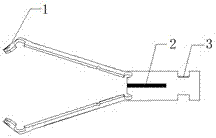Tissue clip capable of continuously releasing and clamping
A tissue clip and clamping technology, applied in the field of hemostatic clips, can solve the problems of hemostatic clip retention, waste of time and equipment, falling off, etc.
- Summary
- Abstract
- Description
- Claims
- Application Information
AI Technical Summary
Problems solved by technology
Method used
Image
Examples
Embodiment Construction
[0028] The technical content of the present invention will be further described in detail below in conjunction with the accompanying drawings and specific embodiments.
[0029] Such as figure 1 figure 2 As shown, the schematic diagrams of the tissue clips in the open state and the tissue clamping state are respectively, wherein 1 is the end of the tissue clip, 2 is the clamping rod, and 3 is the slot at the rear end of the tissue clip.
[0030] Specifically, as image 3 As shown, two tissue clips are connected head-to-tail, and are set in the delivery system tube 5. Here, for the convenience of description, the connection of two tissue clips is shown. The actual connection method of multiple tissue clips is the same, and here we use 2 Take an organization folder as an example. The two tissue clips are connected end to end, and the end 1 of the tissue clip is stuck in the slot 3, so that they will not fall off when they are pushed and pulled in the delivery system tube 5, s...
PUM
 Login to View More
Login to View More Abstract
Description
Claims
Application Information
 Login to View More
Login to View More - R&D
- Intellectual Property
- Life Sciences
- Materials
- Tech Scout
- Unparalleled Data Quality
- Higher Quality Content
- 60% Fewer Hallucinations
Browse by: Latest US Patents, China's latest patents, Technical Efficacy Thesaurus, Application Domain, Technology Topic, Popular Technical Reports.
© 2025 PatSnap. All rights reserved.Legal|Privacy policy|Modern Slavery Act Transparency Statement|Sitemap|About US| Contact US: help@patsnap.com



